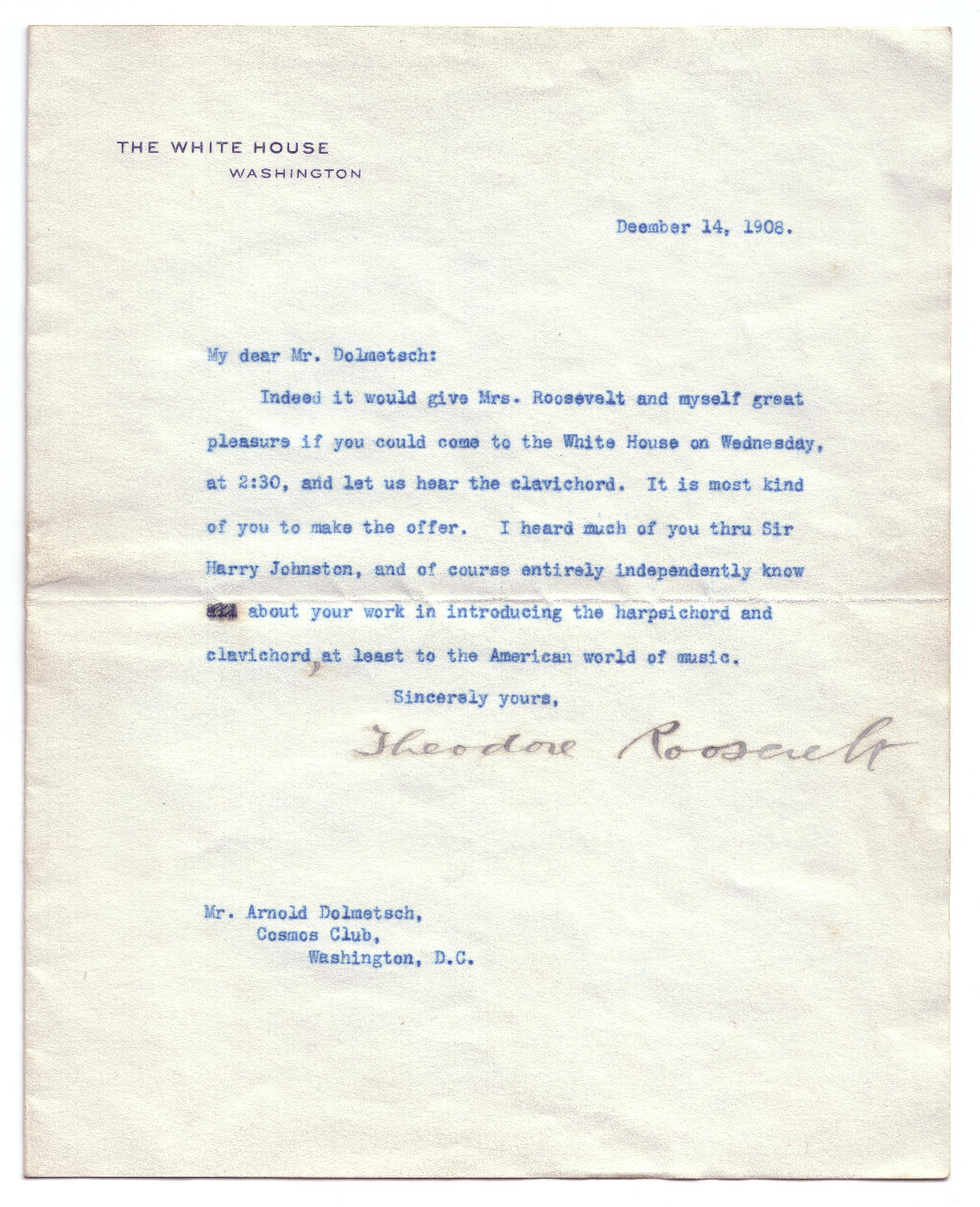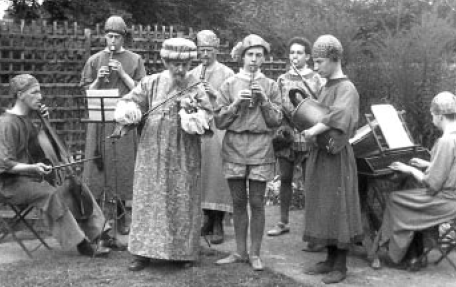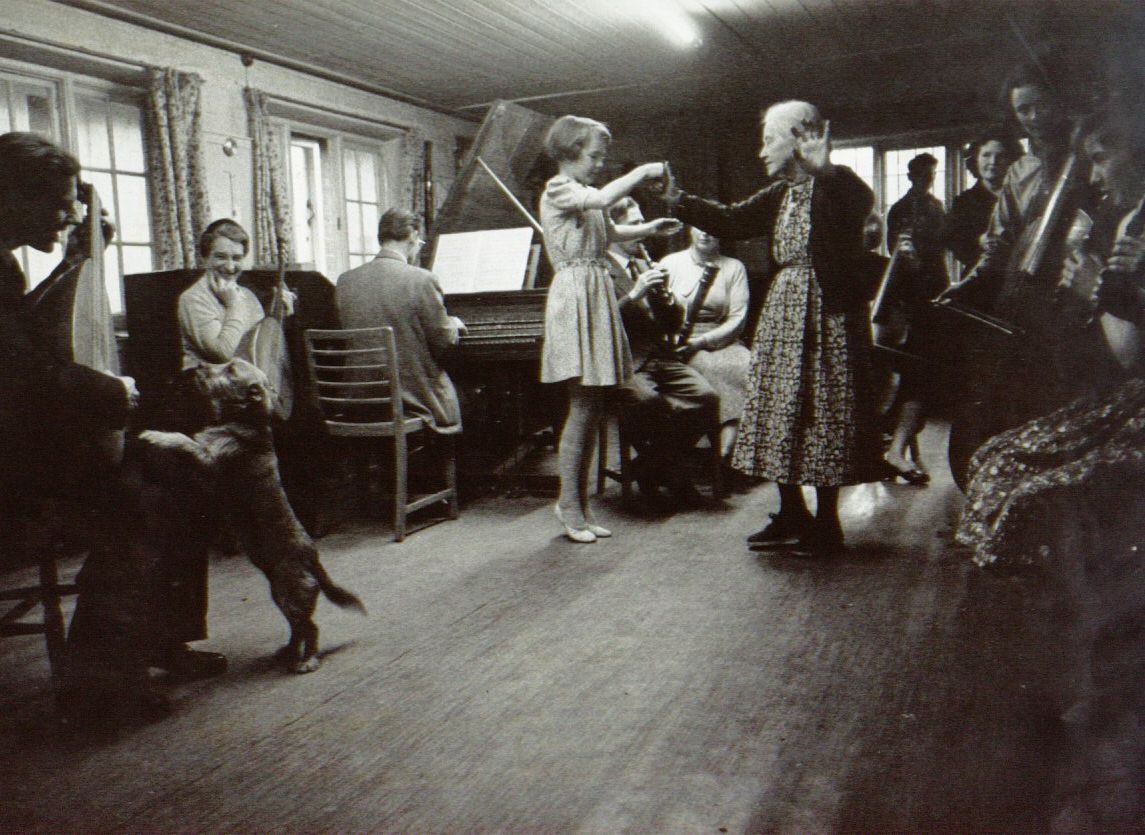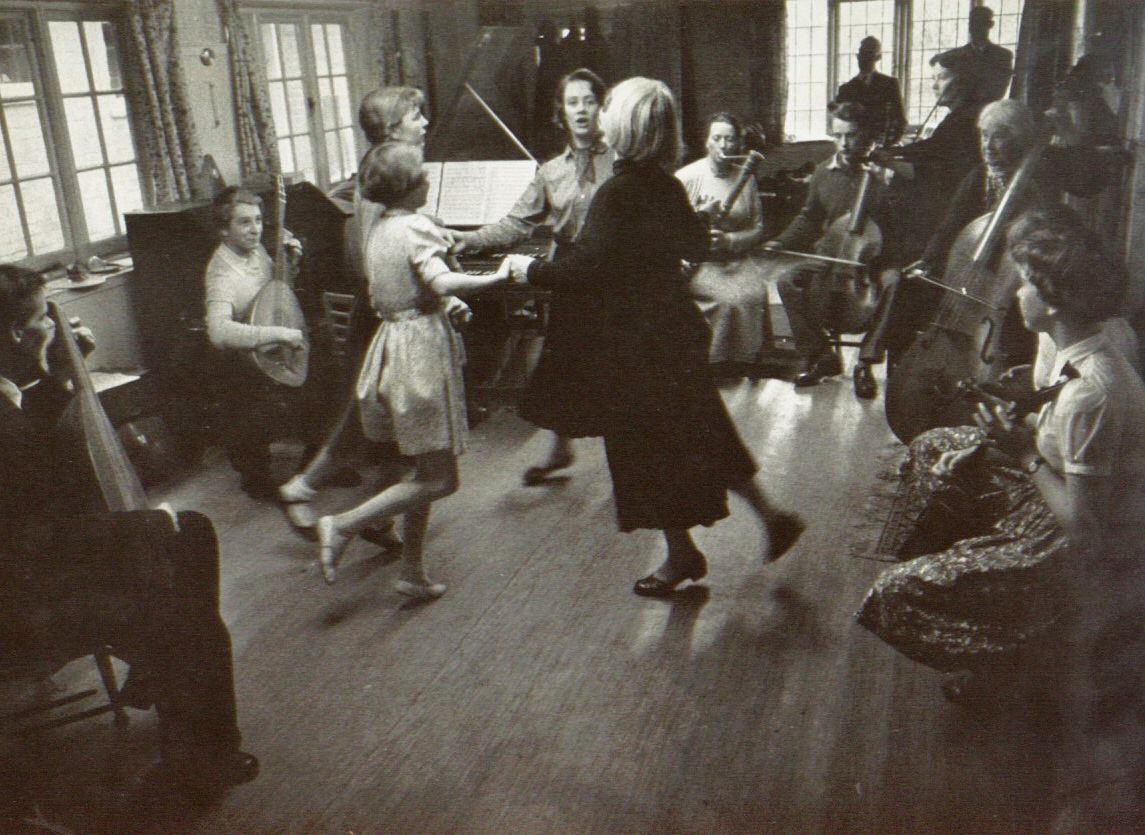The Dolmetsch Story
  | Text The story of this remarkable family and their pioneering work over one hundred and twenty years in the field of early music, The Dolmetsch Story, is available in two versions: online version in English online version in French If you want your own copy, refer to our pdf file archive page. Film There is a short film on Youtube showing Arnold Dolmetsch and his family playing various instruments and, in the case of Mabel Dolmetsch, dancing. We believe the film was shot in 1928 at the family home, Jesses, in Haslemere, Surrey. The information below was drawn from Reflections - Fall 2000 - University of South Carolina, Columbia, S.C. The card for this film clip, no. 1-78, provides only the following: Surrey, England, August 31st, 1928; Shots of Arnold Dolmet[s]ch and family playing old fashioned instruments of 15th & 16th Century; Cameraman, Davis." The Youtube URL is http://www.youtube.com/watch?v=RDcvJRuBAfI. The music is an extract from Divisions on a Ground by Daniel Norcome (c.1576-1655) performed by Rudolph Dolmetsch (viola da gamba) and Arnold Dolmetsch (lute) (taken from Columbia History of Music by Eye and Ear (1929-1933)). We offer a short description of the different scenes that make up the excerpt:
|
Dolmetsch Research
 | The work of the Dolmetsch family, in particular that of Arnold, his third wife Mabel and their four children, Rudolph, Carl, Cécile and Nathalie, is being, or has been, researched by several scholars. The life work of Arnold Dolmetsch and of his son Carl Dolmetsch are both well known but Mabel, Cécile and Nathalie all made significant contributions to various areas of early music. |
 | Mabel, Arnold Dolmetsch's third wife, was skilled in early and modern languages and she translated many original treatises on early dance written in the fifteenth and sixteenth centuries. She published two books on early European dance which are still used by early dance teachers around the world. The Dolmetsch Historical Dance Society is inspired by her contribution to the modern appreciation and understanding of early dance. The picture (taken in the mid-1950s in the 'studio', until the mid-1930s the site of Arnold Dolmetsch's Haslemere workshop, and now gloriously restored as a music room) shows Mabel Dolmetsch dancing with one of her grand-daughters, Marie-Therese Carley, Joseph Saxby at the harpsichord, Carl and Mary Dolmetsch visible under the dancers' arms and Cécile Dolmetsch (Mrs Ward) to the right. Marie-Therese's older sister, Marie-Louise Bailey, is playing the famous Maggini violone. She stands behind a seated Jeanne Dolmetsch who is playing a recorder. Marguerite, Jeanne's twin sister, is also playing the recorder but only her hands are visible. The lutenist, sitting on the far left of the picture, is David Channon (David died in 2014, aged 90); the one nearer the harpsichord is Diana Poulton. |
 | Cécile and Nathalie, sisters of Dr. Carl Dolmetsch, were players of the viol, Nathalie wrote an excellent book on the Viola da Gamba and was president of the Viola da Gamba Society of Great Britain. The second picture (taken at the same time as the one above) shows the 'younger generation' dancing, Nathalie Dolmetsch with her back to us, Marie-Louise Carley facing us and to the left Marie-Therese (her back to us) and a fourth dancer, Rosalind Ward (daughter of Cécile) with plaits. Both Joseph Saxby (at the harpsichord) and Dr. Carl Dolmetsch (playing the recorder) are obscured by the four dancers, but Mary Dolmetsch, Carl's wife, is playing the bass recorder, with Marie-Louise's husband, John Bailey, playing the bass viol, Cécile Dolmetsch, playing the rebec, and Mabel Dolmetsch playing the Maggini violine. On the right, Jeanne Dolmetsch is obscured by her twin sister, Marguerite, who also hold a viol. David Channon is the lutenist on the far left of the picture; the one nearer the harpsichord is Diana Poulton. We maintain a list of Nathalie's writings on the viol as well as information about articles by her sister Cécile and their father Arnold. Cécile was a pioneer in performance on and the promotion of music written for the pardessus d'viol, the sopranino of the viol family which enjoyed a vogue in France in the seventeenth and eighteen centuries. |
Layton Ring has been rediscovering the compositions of Rudolph Dolmetsch, Arnold Dolmetsch's older son who was lost at sea during the Second World War.
Some of the very earliest recordings of early music were made by the Dolmetsch Family. Some of the recordings were published; some were test pressings that were never issued. A few have been reissued using various modern transfer processes and may be obtained through commercial outlets. Others have been issued as commemmorative recordings. Our archive is summarized here.
Teri Noel Towe, an American early recording specialist, has written recently about the 2003 membership gift for the American Bach Society. The title is Bach in Britain in the 1920s.
"One of the most elusive sets of Bach recordings is the first complete traversal of the Brandenburg Concertos, which was recorded by English Brunswick in 1929. The conductor was Anthony Bernard, and the keyboard continuo in all of the Concertos, except No. 5 in which the keyboard solo is played on the piano by Walter Gieseking, was played by Rudolph Dolmetsch. No complete set of the recordings is known to exist, and there are those who argue that none of them ever was actually published. I have managed to obtain copies of sides that contain movements from Nos. 4 (all of the Presto) and Nos. 6 (part one of the first movement). Rudolph's continuo realizations are fantastic, to say the least, and another vivid reminder that his death during World War 2 was an especially grievous loss to classical music in general and early music in specific.
I also plan to include four items from the Arnold Dolmetsch 1933 Bach "48" series (Chromatic Fantasia, WTC 1, Nos. 5, 10, and 22, WTC, No. 1), plus a real treasure that was put into my care many years ago by Arnold Dolmetsch's pupil, Hugh Gough. Hugh Gough told me that he found it in a second hand record store in London. It is a test pressing for the first movement of the Bach Toccata in G, BWV 916, recorded on the harpsichord by Arnold Dolmetsch in 1920. His natural and superbly idiomatic playing is absolutely spectacular! I shall send you a copy of the set, of course, for the Dolmetsch archives, when ithe limited edition is published in the autumn. It really is sad that none of the 11 sides that Arnold Dolmetsch made for HMV at Hayes in 1920 has ever been published. I have never seen a "repertory list", but I gather that he recorded on many different instruments."
Andrew Mayes' book about 20th century recorder works commissioned by, dedicated to or inspired by Carl Dolmetsch entitled Carl Dolmetsch and the Recorder Repertoire of the 20th Century is now available; (see also the monograph by Ross Winters entitled The Dolmetsch Legacy - recorder works written for Carl Dolmetsch); many are studying the correspondence of Arnold Dolmetsch with members of the Arts & Crafts Movement, and of Arnold Dolmetsch with major figures of the early twentieth century music including Percy Grainger and Ernest Ansermet.
Among the works dedicated to Carl Dolmetsch and performed by him are about sixty that have never been published. Jeanne Dolmetsch, in conjunction with Peacock Press, is preparing and publishing critical editions of all these works which began appearing in print in the Summer of 2001.
Margaret Campbell's book on the life and work of Arnold Dolmetsch and Mabel Dolmetsch's biography of Arnold Dolmetsch, both available from us, remain the central published sources on this extraordinary pioneering family.
References
Books & Articles
Dolmetsch: the man and his work by Margaret Campbell (Hamish Hamilton, 1975)
Personal Recollections of Arnold Dolmetsch by Mabel Dolmetsch (reprint available from The Dolmetsch Workshops)
The Interpretation of the Music of the Seventeenth and Eighteenth Centuries by Arnold Dolmetsch (1915) (reprint includes Appendix of Musical Examples) from Dolmetsch
Scanned copy of The Interpretation of the Music of the Seventeenth and Eighteenth Centuries by Arnold Dolmetsch (1915) in pdf format
The Early Music Revival - A History by Harry Haskell (Thames and Hudson, 1988)
'Vers Libre and Arnold Dolmetsch' by Ezra Pound, in Literary Essays, ed. T.S. Eliot (Faber & Faber, 1974)
Carl Dolmetsch and the Recorder Repertoire of the 20th Century by Andrew Mayes (Ashgate, Aldershot, 2003)
'The Six Early Clavichords of Arnold Dolmetsch: Their Construction and Inspiration.' by Jenny Nex and Lance Whitehead (The Galpin Society Journal 53, April 2000: pp 274-300).
'Arnold Dolmetsch, The 1890's' by Brian Abel Ragen; An Encyclopedia of British Culture, ed. George A. Cevasco (Garland, 1993), 165-66.
'James Joyce as a Tenor' from Intimations by Oliver St John Gogarty (Sphere Books, 1985) which records that "all he [Joyce] wanted was a lute made by Dolmetch [sic] and the proper English audiences."
Online (HTML and pdf format)
Arnold Dolmetsch (1858-1940) by Sharon Cogdill
Dolmetsch Archival Recordings
Dolmetsch Family Tree - incomplete
The Dolmetsch Family - Encarta
Arnold Dolmetsch - Oxford Dictionary of Music Entry
Arnold Dolmetsch - particularly related to his clavichords
The Clavichord in 20th Century America by Joan Benson
Arnold Dolmetsch's Clavichord-Making in the Years before 1914 by Peter Bavington - originally published in De Clavicordio VIII (Magnano, 2008)
Arnold Dolmetsch - Encyclopedia Britannica Entry
Arnold Dolmetsch - MSN Encarta Entry
Close harmony of viol bodies by Bayan Northcott
Arnold Dolmetsch - Dolmetsch and Ezra Pound
Arnold Dolmetsch - Wikipedia Entry
Mabel Dolmetsch (1874–1963) biography
Hélène Dolmetsch (1878-1924) - Arnold Dolmetsch's oldest daughter
Rudolph Dolmetsch (1906-1942) - eldest son of Arnold Dolmetsch
Rudolph Arnold Dolmetsch (1906-1942) - Royal College of Music Entry
Cécile Dolmetsch (1904-1997) - Obituary
Carl Dolmetsch (1911-1997) - Obituary
Carl Dolmetsch (1911-1997) - Obituary on the web site of the UK Society of Recorder Players
Carl Dolmetsch (1911-1997) - An Appreciation by Ian White of the Viola d'Amore Society
Carl Dolmetsch Recordings
The British Clavichord Society at Haslemere: the work of Arnold Dolmetsch by Kenneth Mobbs
The Arnold Dolmetsch clavichord of 1896-7 in the Edinburgh University Collection: a restoration report by John Barnes
From William Morris to Morris Dancing
William Morris and Music - Craftsman's Art
Morris and Early Music: the Shaw/Dolmetsch Connection
The Literary After-Life of Arnold Dolmetsch
On Ezra Pound's Canto 81
Olga Rudge and Ezra Pound which mentions Ezra Pound's Dolmetsch clavichord
The Countess Cathleen and the Revival of The Bardic Arts - Dolmetsch and Yeats (pdf format)
Percy Grainger photograph of Arnold Dolmetsch and his family
After A Dolmetsch Concert - Poem by Arthur Upson (1877-1908)
Arnold Dolmetsch, Violet Gordon Woodhouse, Mrs Crawley and their harpsichords
A Chest of Viols - Poem by John Todhunter (1839-1916) - inscribed to Arnold Dolmetsch
To Elodie - Singing an old English Air - Poem by John Todhunter (1839-1916) - addressed to Arnold Dolmetsch's wife Elodie
Narcissus - Poem by John Betjeman (1906-1984)
Arnold Dolmetsch and Georges Barrère (1876-1944)
Sol Babitz writes on The Landowska Approach
Violet Gordon-Woodhouse and Arnold Dolmetsch
Marco Pallis - pupil of Arnold Dolmetsch
A Suitecase in the Attic - the story of Cyril and Mary Goldie
Hommage à Antoine Geoffroy-Dechaume (1905-2000) - including his meeting with Arnold Dolmetsch
Scott Ross biography - his link with Antoine Geoffroy-Dechaume and Arnold Dolmetsch
The Robert ap Huw manuscript (B. M. Addl. MS 14905) - including reference to Arnold Dolmetsch's work in this area
Female Dolmetsch Family Musicians
The Horniman Museum Collections
Layton Ring (1922-2019) - An Appreciation
Carl Dolmetsch, The Three-Holed Pipe and Cecil Sharp
A Short History of the Chickering Piano Co.
Chickering & Sons Piano Company Collection, 1864-1985 at the Smithsonian Institution
The Harpsichord in America 1884-1946 by William Lyman Johnson
Harpsichord in America: A Twentieth-Century Revival
The Treasure Room of Vassar College Department of Music - including a Chickering Clavichord made by Dolmetsch in 1909
Nicholas Comyn Gatty (1874-1946) - composer of Haslemere Suite for strings
Arnold Dolmetsch playing an alto recorder (taken in 1914) - by Alvin Langdon Coburn (b. US, 1882-1966)
Transcriptions of Musical Illustrations - including some by members of the Dolmetsch family
George Moore's Evelyn Innes: Zola's Pupil and His Tale of Love and Early Music in Fin de Siècle Dulwich
George Moore - author of Evelyn Innes drawn from the life and work of Arnold Dolmetsch
Dickens by G**rge M**re from A Christmas Garland by Max Beerbohm
The Dolmetsch Legacy - recorder works written for Carl Dolmetsch
Société des amis de A. Dolmetsch - an association based in Le Mans, France
Brian Blood and The Blood Family
